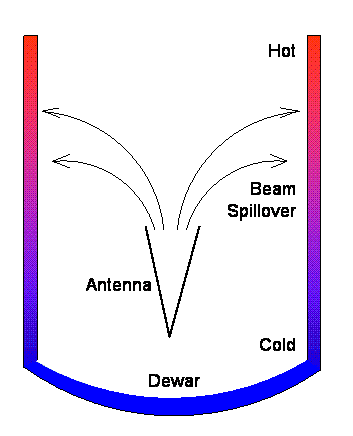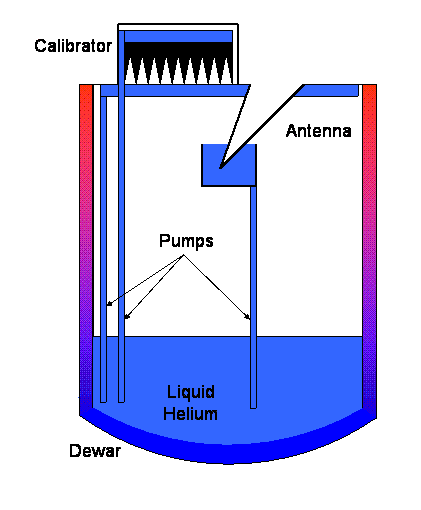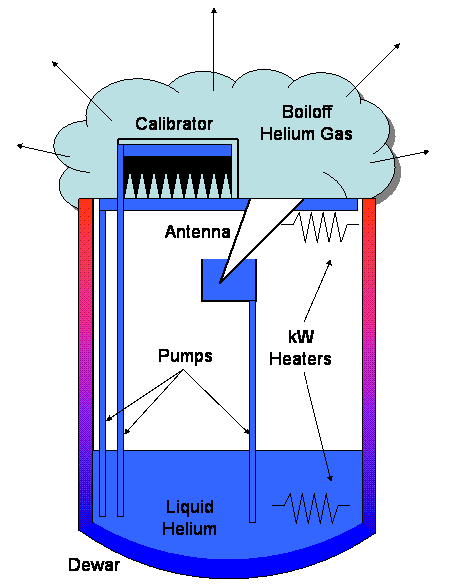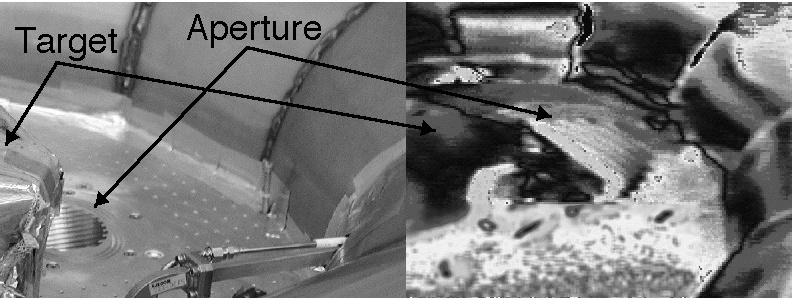 |
 |
Stupid Dewar Tricks
ARCADE at heart is a thermal experiment.
That is, the major technical challenge is not building
ultra-precise state-of-the-art radiometers,
but rather maintaining big chunks of metal at
precisely known temperatures near absolute zero
while sitting in a helium hurricane.
ARCADE has one central design principle:
Maintain the instrument at 2.7 K
with no warm objects between the cold optics and the sky.
This forces some creative cryogenic solutions.
Where Do The Cold Optics Go?

|
Dewars exist to isolate the cold interior from the heat of
the outside world. Any sane person would put the cold optics
at the very bottom of the dewar, so that the dewar walls could
take up the thermal gradient between the 2.7K optics and the
250 K exterior. Not us. If the antennas were near the bottom
of the dewar, the beams would have some view of the walls.
We would then have to correct our data to account for the
contribution from the walls. We don't want to correct the data,
so the cold optics move up to the very top of the bucket dewar!
|
How Do We Keep The Optics Cold?

|
If the cold optics are moved to the top of the dewar,
how do we keep them cold when they're sitting just a few centimeters
from an outside world that's hundreds of degrees warmer?
Simple: we drench them in liquid helium!
Fountain effect pumps
move superfluid liquid helium
from the bottom of the dewar to reservoirs
on the radiometers, the aperture plane,
and the external calibrator.
ARCADE uses over a dozen pumps,
each capable of lifting several liters of superfluid helium
per minute up the 2-meter height of the dewar.
|
How Do We Keep The Air From Freezing All Over The Optics?

|
Now we have cold optics sitting at the mouth of an open bucket dewar.
The optics are really cold: 2.7 K, or -454 F.
Air (nitrogen) freezes solid at 63 K (-346 F).
Why doesn't the whole dewar fill up with frozen nitrogen?
A sane person would mount a thin window between the
cold optics and the outside world, just to keep things from
freezing onto the optics. Not us!
For a window to be effective at preventing freezing,
it must remain hotter than the freezing point of air,
in which case we would have to correct our data
for the contribution from the warm window.
Instead, we install heaters inside the dewar
to intentionally boil off huge amounts of helium,
then vent the boiloff gas through the aperture.
We vent a lot of gas --
more than a cubic meter of helium gas per second throughout
the entire flight.
The boiloff gas acts as a barrier
between the atmosphere and the cold optics,
preventing nitrogen from reaching the optics
where it could freeze.
|
Does This Really Work?

|
That all sounds very nice, but does it work in practice?
The picture above compares an image of the optics
taken on the ground to a video still taken in flight
during the 2001 campmaign.
The left-hand panel shows the optics at room temperature.
The corrugated horn antenna is visible behind the
calibrator target in the foreground.
The right-hand panel shows a similar view captured in flight,
about an hour after the ascent lid opened
to expose the instrument to the sky.
The corrugations are still clearly visible behind the target.
Detailed examination shows a minor amount of nitrogen frost
collecting on the optics -- about what you'd scrape off
a car windshield on a cold, clear morning.
Once the frost forms on the optics,
it cools to the same temperature (2.7 K) as the metal surfaces
and does not present a problem for the measurement.
|
|
|


